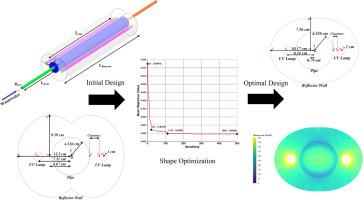基于反射器形状优化的cfd辅助UV- H2O2高级氧化过程强化
IF 3.9
3区 工程技术
Q3 ENERGY & FUELS
Chemical Engineering and Processing - Process Intensification
Pub Date : 2025-08-20
DOI:10.1016/j.cep.2025.110517
引用次数: 0
摘要
与传统反应器相比,在高级氧化过程中加入反射器在新型反应器的维护和性能方面都具有优势。针对一种新型光反应器,建立了蒙特卡罗辐射模拟方法,并将其集成到遗传算法中,以优化反射器的形状,以最大限度地吸收排放管上的辐射。为了评估具有优化和非优化反射器以及传统光反应器的整体性能,使用经过验证的计算流体动力学(CFD)模型模拟了流体流动、辐射分布和化学反应。在三种光反应器设计中,流速、辐射功率和入口污染物浓度保持不变,以比较三丁基磷酸(TBP)、三氯乙基磷酸(TCEP)和三丁氧乙基磷酸(TBEP)模型污染物的降解效率。在10加仑/分钟(GPM)的流速下,与传统光反应器相比,优化后的光反应器对TBP、TCEP和TBEP的降解率分别提高了14.12%、5.96%和8.37%。与未优化反射镜的光反应器相比,降解率分别提高了4.33%、2.52%和2.1%。本文章由计算机程序翻译,如有差异,请以英文原文为准。

A CFD-assisted UV- H2O2 advanced oxidation process intensification in a novel photoreactor through reflector shape optimization
Incorporating reflectors in advanced oxidation processes offers advantages in both the maintenance and performance of novel reactors when compared to conventional ones. A Monte Carlo radiation simulation was developed for a novel photoreactor and integrated into a genetic algorithm to optimize the shape of reflectors for maximum radiation absorption on the effluent pipe. To assess the overall performance of photoreactors with optimized and non-optimized reflectors, as well as conventional photoreactors, the fluid flow, radiation distribution, and chemical reactions were simulated using a well-validated computational fluid dynamics (CFD) model. The flow rate, radiative power, and pollutant concentration at the inlet were held constant across the three photoreactor designs to compare the degradation efficiency of model pollutants, namely Tributyl Phosphate (TBP), Tri 2-Chloroethyl Phosphate (TCEP), and Tri 2-Butoxyethyl Phosphate (TBEP). At a flow rate of 10 gallons per minute (GPM), the photoreactor with optimized reflectors showed 14.12 %, 5.96 %, and 8.37 % higher degradation of TBP, TCEP, and TBEP, respectively, compared to the conventional photoreactor. When compared to the photoreactor with non-optimized reflectors, the degradation rates improved by 4.33 %, 2.52 %, and 2.1 %, respectively.
求助全文
通过发布文献求助,成功后即可免费获取论文全文。
去求助
来源期刊
CiteScore
7.80
自引率
9.30%
发文量
408
审稿时长
49 days
期刊介绍:
Chemical Engineering and Processing: Process Intensification is intended for practicing researchers in industry and academia, working in the field of Process Engineering and related to the subject of Process Intensification.Articles published in the Journal demonstrate how novel discoveries, developments and theories in the field of Process Engineering and in particular Process Intensification may be used for analysis and design of innovative equipment and processing methods with substantially improved sustainability, efficiency and environmental performance.

 求助内容:
求助内容: 应助结果提醒方式:
应助结果提醒方式:


